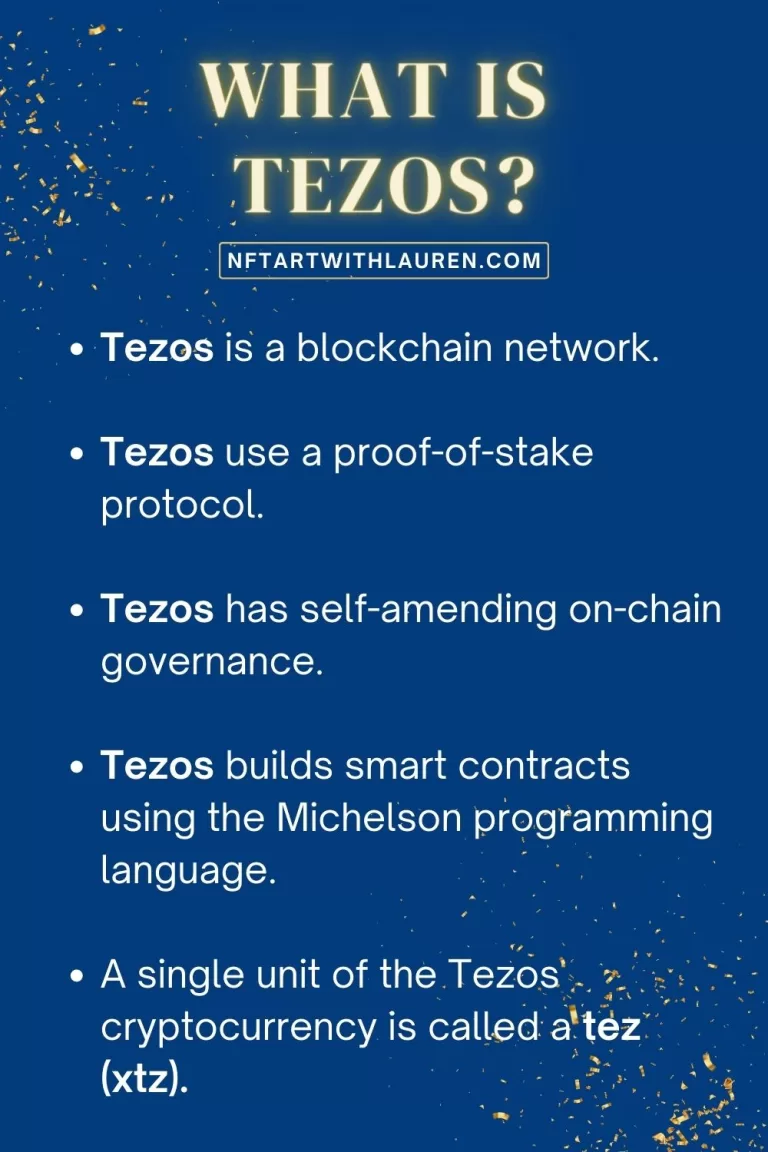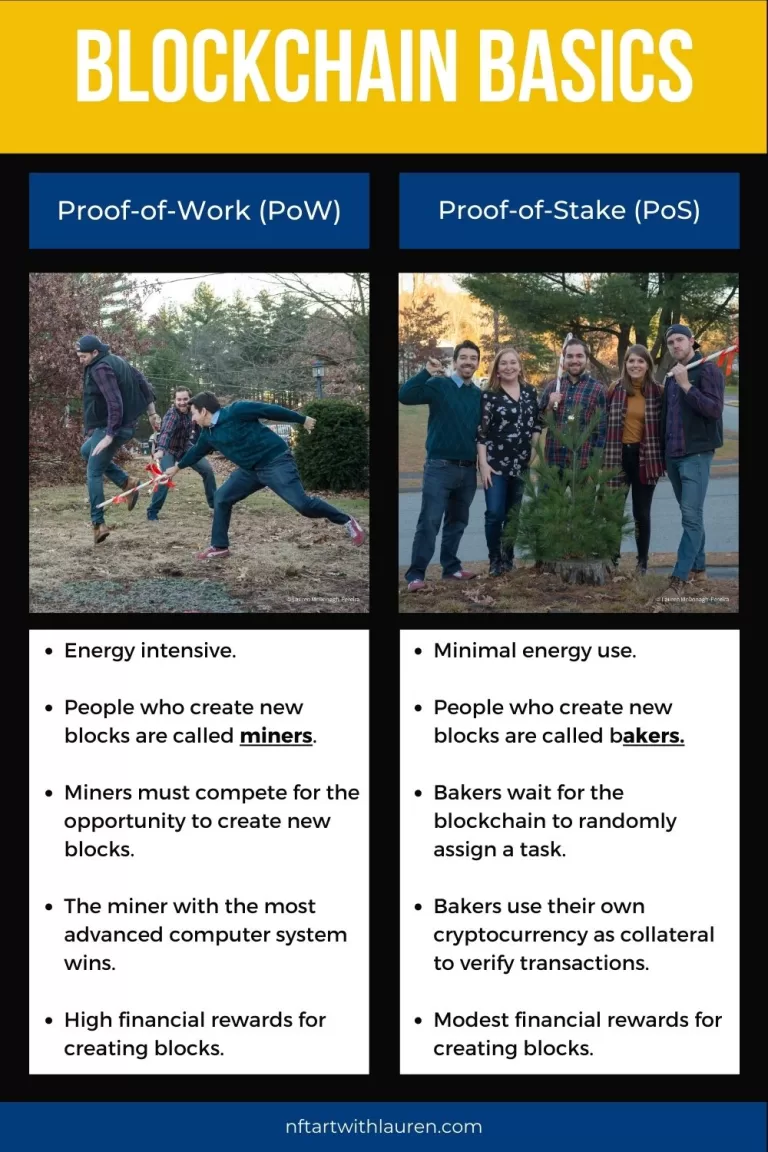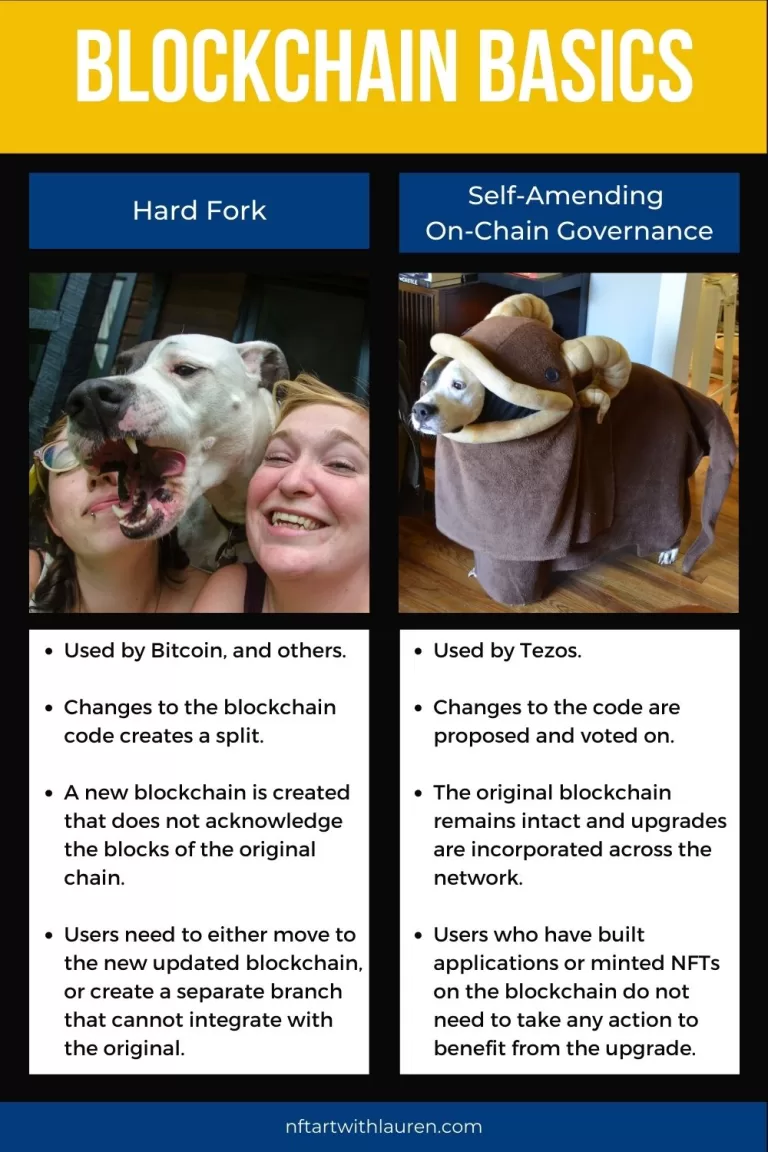What is Tezos? (A Unique Blockchain)
What is Tezos?
Tezos is a blockchain network. It uses tez (xtz) as its cryptocurrency.
Tezos sets itself apart from other major blockchains because it uses a proof-of-stake protocol, updates itself with self-amending on-chain governance, and its smart contracts are written with the ‘Michelson’ programming language.
Tezos is a popular blockchain for artists of all genres, who create Tezos NFTs out of photographs, paintings, drawings, AI-art, music files, poetry, long-form writing, GIFs, and videos.
In this article, I will cover some of the technical details of the blockchain.
My name is Lauren McDonagh-Pereira. I am a photographer, NFT artist, NFT collector, and web3 blogger. I have been fully immersed in the NFT art space since February 2022.
Curious? Read on beyond my disclaimer for an introduction to the Tezos blockchain.

Disclaimer
[caption id="attachment_746" align="aligncenter" width="300"]

ⓒ Lauren McDonagh-Pereira Photography 2013[/caption]
Before we get into it, please consider a few quick DISCLAIMERS.
I am not a financial advisor, an art expert, a lawyer, or an accountant. Always do your own research before purchasing NFTs and never spend money that you cannot afford to spend.
This post represents my personal opinions and is NOT financial advice.
I am an NFT artist. At the time of posting, I have works minted on the Tezos and Ethereum blockchains. Links contained in this article may point to my own minted NFTs or may point to the NFTs of other artists that I have collected from. If you choose to collect NFTs referenced in this article, I may earn money from your purchase.
Review my Privacy Policy here.
Proof-Of-Stake
What Does Proof-of Stake Mean?
Tezos is built with a proof-of-stake protocol. It is self-amending. And it relies on community governance to make amendments to its protocol.
Proof-of-stake (PoS) is one of two cryptocurrency consensus mechanisms used to create new blocks in a blockchain and process blockchain transactions. Proof-of-Work (PoW) is the alternative consensus mechanism that is used by Bitcoin.
Proof-of-stake systems use significantly less energy than the older proof-of-work protocols. In PoS, a community of validators (users who have staked a minimum number of cryptocurrency coins) are randomly chosen to validate transactions on the blockchain. They earn the small transaction fee as a reward. With PoW, miners compete to create new blocks in the blockchain with increasingly advanced computer equipment. Because the validation assignments in a PoS system are randomized, there is no incentive for validators to build or run energy intensive computer equipment
What Does Proof-of-Stake Mean in Simple Terms?
In a nutshell, proof-of-stake works by having bakers sit around and wait patiently. Imagine a baker as a student in a classroom. The teacher is the blockchain who wants someone to create the next block. All the bakers are like students sitting calmly with their hands raised hoping that the teacher will call on them. The rewards are low, but the energy spent to get the reward is also low.
Proof-of-work is like an athletic competition. Miners are like athletes who have to compete for every opportunity. They have to constantly upgrade their performance level if they hope to win the right to create a new block. The financial reward for creating a new block is high.
It is similar to the way in which professional athletes are rewarded with multi-million dollar contracts, but they must train their whole lives to achieve that level of performance, and countless millions of athletes devote large amounts of time and energy to athletic training without ever getting the chance to compete professionally. The rewards are high, but the energy costs are exorbitant.
How Does Proof-of-Stake Benefit Tezos?
The Proof-of-Stake protocol is a strong selling point of Tezos. On Twitter, artists commonly use the hashtag #CleanNFTs when they are talking about their Tezos work.
Tezos is viewed as an environmentally friendly alternative to other blockchains which are notorious for consuming obscene amounts of energy. As more people begin to use blockchain technology, it is crucial that the energy costs remain as low as possible.
Tezos is a leader in working towards that goal.

Blockchain Basics by nftartwithlauren.com
Self-Amending On-Chain Governance
What Does Self-Amending On-Chain Governance Mean?
Tezos is a self-amending blockchain network. The blockchain itself has a formal system in which bakers (the people who create and verify new blocks) can propose, select, test, and activate protocol upgrades. This process allows Tezos to upgrade its code and functionality without creating any hard forks.
Other blockchains, such as Bitcoin, do not have self-amending on-chain governance. This means that when the Bitcoin community of miners needs to make a change to the protocol they need to create a hard fork in the system.
When a hard fork occurs, the code of the blockchain splits into two separate chains. The pieces of code that branched off from the original chain, no longer recognize the earlier blocks. All users of the blockchain need to either adapt to the new code or create a separate blockchain.
Previous hard forks are the reason that you will see so many coins with “Bitcoin” in their name when you log into Coinbase⁵.
Tezos avoids this problem with its on-chain governance system.
Tezos has a set cycle during which bakers can propose changes to the code that would improve the blockchain’s performance or security. This sets off a cycle during which other bakers can explore the proposed changes, test the changes, debate the changes and then vote on whether or not to adopt the changes. If a vote fails, the cycle goes back to the proposal period and new code changes are submitted.
What Does Self-Amending On-Chain Governance Mean in Simple Terms?
Essentially, Tezos has the ability to upgrade itself over time. The community of Tezos investors and bakers can vote on changes to the code. This is similar to the way investors in a publicly-traded company can vote on changes within a cooperation that they own shares of.
Technology is always adapting and changing. Over time, new security risks will pop up, users will expect faster processing speeds, and people will want the ability to mint larger files. With self-amending on-chain governance, the original Tezos blockchain can simply adapt to these changes without having to branch off to create a whole new version of Tezos.
How Does the Self-Amending On-Chain Governance Benefit Tezos?
Tezos’ self-amending on-chain governance means that the blockchain is built to last.
As more people onboard to mint art or build applications on the Tezos network, the original Tezos blockchain can grow to meet these challenges.

Blockchain Basics by nftartwithlauren.com
Michelson Language Smart Contracts
What is a Michelson Smart Contract?
A smart contract is a code built on a blockchain.
The code is called a contract because it builds an “If/then” event. If you buy my NFT, then I receive the specified amount of cryptocurrency. If you sell my NFT, then I receive the royalty that I specified when I minted it.
The code is “smart” because it cannot be tampered with, so it does not need to be verified to assure its authenticity.
When a command is entered into a smart contract (such as sending cryptocurrency or buying an NFT), the entire file is sent to multiple servers. Each server executes the command. If all servers produce an identical result, the transaction can be verified.
Tezos uses a programming language called Michelson. In Michelson, bits of code are added in secure stacks. This stack-based programming language allows developers to build smart contracts and decentralized applications that cannot be shut-down by third parties.
Michelson also uses a formal verification system that provides optimum security for the integrity of the smart contracts built with the code.
What is a Smart Contract in Simple Terms?
A smart contract is a computer program that makes sure a document is legitimate.
Imagine that you hold in your hands, what you believe to be, an original copy of the Declaration of Independence. You want to sell this document at auction, but first it needs to be authenticated as the real deal.
You bring your copy of the Declaration of Independence to a museum to meet an expert in carbon dating paper. The expert checks out the artifact, and determines that the paper is from the correct era. You then give the document to a hand-writing expert. The expert studies it, and determines that the signatures are original. You then bring the document to a historian who scrutinizes the text for inaccuracies, finds none, and agrees that you are holding a piece of American history in your hands.
After all three experts have agreed that this is really an original copy of the Declaration of Independence, you can bring it over to an auction house where a buyer can collect it with confidence.
A smart contract completes this process automatically. When your wallet wants to purchase an NFT, the smart contract sends the code of the NFT to multiple servers simultaneously. Each server looks it over, gives its seal of approval, and allows the transaction to move forward.
How Does Tezos Benefit from the Michelson Smart Contract?
The smart contracts on the Tezos blockchain are built on low-level stack-based programming language.
This provides Tezos with security, a way to avoid bugs in the system, and freedom from third-party censorship.

Blockchain Basics by nftartwithlauren.com
Conclusion
Tezos is a secure blockchain. It is energy-efficient. It is run democratically. And it is positioned to evolve alongside blockchain technology and wider mainstream adoption.
As an artist, Tezos is my favorite choice for minting and selling NFTs. As a collector, Tezos NFTs are my favorite to browse and collect.
Are you part of the Tezos community? Let me know in the comments.
References
Arluck, J. (2020, May 13). Amending tezos: Medium. Retrieved January 15, 2023, from https://medium.com/tezos/amending-tezos-b77949d97e1e
Frankenfield, J. (2022, October 10). Hard fork: What it is in blockchain, how it works, why it happens. Investopedia. Retrieved January 15, 2023, from https://www.investopedia.com/terms/h/hard-fork.asp
Frankenfield, J. (2023, January 10). What does proof-of-stake (pos) mean in crypto? Investopedia. Retrieved January 15, 2023, from https://www.investopedia.com/terms/p/proof-stake-pos.asp#:~:text=Investopedia%20%2F%20Crea%20Taylor-,What%20Is%20Proof%2Dof%2DStake%20(PoS)%3F,and%20keeping%20the%20database%20secure
Frankenfield, J. (2023, January 10). What does proof-of-stake (pos) mean in crypto? Investopedia. Retrieved January 15, 2023, from https://www.investopedia.com/terms/p/proof-stake-pos.asp#:~:text=Investopedia%20%2F%20Crea%20Taylor-,What%20Is%20Proof%2Dof%2DStake%20(PoS)%3F,and%20keeping%20the%20database%20secure
Goodman, L. M. (2014, September 2). Tezos — a self-amending crypto-ledger white paper. tezos.com. Retrieved January 15, 2023, from https://tezos.com/whitepaper.pdf
Matt. (2022, April 17). What is Tezos?: Addressing blockchain weaknesses. Wealth Mastery by Lark Davis - Crypto Newsletter. Retrieved January 15, 2023, from https://thewealthmastery.io/what-is-tezos/
Michelson: The language of smart contracts in tezos. Michelson: the language of Smart Contracts in Tezos - Tezos (master branch, 2023/01/15 06:47) documentation. (n.d.). Retrieved January 15, 2023, from https://tezos.gitlab.io/active/michelson.html#:~:text=A%20smart%20contract%20is%20a,creation%2C%20and%20starts%20with%20KT1%20
Open Tezos. (n.d.). Governance on-chain. OpenTezos. Retrieved January 15, 2023, from https://www.opentezos.com/tezos-basics/governance-on-chain/
Polys. (2018, April 5). Smart contracts for dummies. Medium. Retrieved January 15, 2023, from https://medium.com/@polysvote/smart-contracts-for-dummies-e8f332275c56
Smart contracts on Tezos. Tezos Wiki. (n.d.). Retrieved January 15, 2023, from https://wiki.tezos.com/build/smart-contracts/intro
More to explore
KEEP READING

MEET Lauren McDonagh-Pereira
Lauren McDonagh-Pereira is a photographer from Massachusetts, USA. She captures the beauty of the world around her, favoring Nikon cameras and lenses. She is drawn to shooting landscapes, wildlife, nature, and people authentically enjoying life.
Twitter Twitter Instagram Linkedin Pinterest Facebook Tiktok Youtube


%26blogName%3DLAMP%2520on%2520Web3%26blogImageUrl%3Dhttps%253A%252F%252Fstorage.googleapis.com%252Fpapyrus_images%252F5e00e82e9ae0a73d42236e1f5c2a573a.jpg%26coverPhotoUrl%3Dhttps%253A%252F%252Fstorage.googleapis.com%252Fpapyrus_images%252Fa4c5e0e52ea806bb63726f15e62a0f33.jpg%26size%3D1024%26publishedDate%3D1673822629000&w=3840&q=75)

https://paragraph.xyz/@lampphotography/what-is-tezos-a-unique-blockchain
🌷 🌷 🌷 🌷